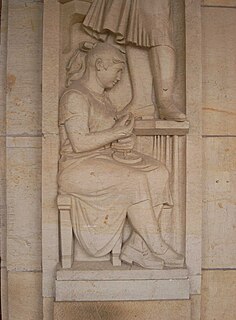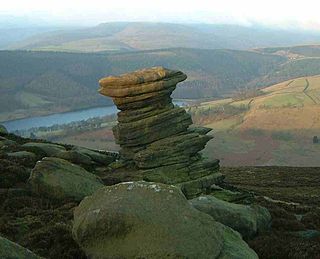 W
WSandstone is a clastic sedimentary rock composed mainly of sand-sized silicate grains. Sandstones make up about 20 to 25 percent of all sedimentary rocks.
 W
WThis is a list of types of sandstone that have been or are used economically as natural stone for building and other commercial or artistic purposes.
 W
WArenite is a sedimentary clastic rock with sand grain size between 0.0625 mm (0.00246 in) and 2 mm (0.08 in) and contain less than 15% matrix. The related adjective is arenaceous. The equivalent Greek-derived term is psammite, though this is more commonly used for metamorphosed sediments.
 W
WArkose is a detrital sedimentary rock, specifically a type of sandstone containing at least 25% feldspar. Arkosic sand is sand that is similarly rich in feldspar, and thus the potential precursor of arkose.
 W
WBollinger Sandstein or Bollingen Sandstone is a sandstone found on Obersee lake shore, namely between Bollingen and Uznach and Buechberg area, in the cantons of St. Gallen and Schwyz in Switzerland.
 W
WBrownstone is a brown Triassic–Jurassic sandstone that was once a popular building material. The term is also used in the United States to refer to a townhouse clad in this, or any of a number of aesthetically similar materials.
 W
WCarrstone is a sedimentary sandstone conglomerate formed during the Cretaceous period. It varies in colour from light to dark rusty ginger. Used as a building stone it can be found in Bedfordshire, Cambridgeshire and extensively in the historic buildings of north-west Norfolk.
 W
WLas Gredas de Bolnuevo, also called Ciudad Encantada, are heavily eroded sandstone formations along the beach of Bolnuevo, Murcia, Spain. The sandstone shapes are sculpted by water and wind over thousands of years and are considered as a monument of natural interest.
 W
WCotta Sandstone, is found in the Elbe Valley and in its numerous tributary valleys. Its main deposit lies in the west of the Elbe Sandstone Mountains, where it runs up to the Bohemian border, ending south of Pirna. It is named after the village of Cotta in the borough of Dohma, an area where the stone is quarried.
 W
WElbe Sandstone describes sandstones that naturally occur in North Bohemia and those parts of Saxony within the area around Dresden. It is named after the River Elbe, which cuts through the sandstone region in a transverse valley, the Elbe Valley Zone. It reaches the surface most strikingly in the Elbe Sandstone Mountains, which are divided into the regions of Saxon Switzerland on German soil and Bohemian Switzerland on Czech territory. The term Elbe Sandstone is used in both geological and economic contexts.
 W
WFlagstone (flag) is a generic flat stone, sometimes cut in regular rectangular or square shape and usually used for paving slabs or walkways, patios, flooring, fences and roofing. It may be used for memorials, headstones, facades and other construction. The name derives from Middle English flagge meaning turf, perhaps from Old Norse flaga meaning slab or chip.
 W
WGreensand or green sand is a sand or sandstone which has a greenish color. This term is specifically applied to shallow marine sediment that contains noticeable quantities of rounded greenish grains. These grains are called glauconies and consist of a mixture of mixed-layer clay minerals, such as smectite and glauconite mica. Greensand is also loosely applied to any glauconitic sediment.
 W
WGreywacke or graywacke is a variety of sandstone generally characterized by its hardness, dark color, and poorly sorted angular grains of quartz, feldspar, and small rock fragments or lithic fragments set in a compact, clay-fine matrix. It is a texturally immature sedimentary rock generally found in Paleozoic strata. The larger grains can be sand- to gravel-sized, and matrix materials generally constitute more than 15% of the rock by volume. The term "greywacke" can be confusing, since it can refer to either the immature aspect of the rock or its fine-grained (clay) component.
 W
WGrillenburg Sandstone and Niederschöna Sandstone belong to the Elbe Sandstones of central Europe. There used to be a number of sandstone quarries in the Tharandt Forest and its neighbourhood, not far from Höckendorf and Ruppendorf, near Grillenburg, Niederschöna and Hetzdorf in the state of Saxony. These Cretaceous sandstones emerged in the Cenomanian and Turonian ages. The aforementioned quarries have long since closed.
 W
WGritstone or grit is a hard, coarse-grained, siliceous sandstone. This term is especially applied to such sandstones that are quarried for building material. British gritstone was used for millstones to mill flour, to grind wood into pulp for paper and for grindstones to sharpen blades. "Grit" is often applied to sandstones composed of angular sand grains. It may commonly contain small pebbles.
 W
WHolystone is a soft and brittle sandstone that was formerly used in the Royal Navy and US Navy for scrubbing and whitening the wooden decks of ships.
 W
WItacolumite is a naturally occurring porous, yellow sandstone that is flexible when cut into thin strips. It occurs at Itacolumi, in the southern portion of Minas Gerais, Brazil. It is also found in Kaliana village ; Georgia in the US; and Stokes and McDowell counties of North Carolina. It is the best and most widely known example of a flexible sandstone and is a source of diamonds found in the Minas Gerais area.
 W
WLithic sandstones, or lithic arenites, or litharenites, are sandstones with a significant (>5%) component of lithic fragments, though quartz and feldspar are usually present as well, along with some clayey matrix. Lithic sandstones can have a speckled or gray color, and are usually associated with one specific type of lithic fragment.
 W
WPosta Sandstone also called Wehlen Sandstone, only occurs on the eastern banks of the River Elbe at Alte Poste, near Herrenleithe, Wehlen, Zeichen and Posta. The thickness of the deposit is between 30 and 50 metres. It is also known as Überquader and has the smallest deposit of all the Elbe sandstones. In 2008 it was being quarried in the areas around the village of Lohmen and in Wehlen.
 W
WA QFL diagram or QFL triangle is a type of ternary diagram that shows compositional data from sandstones and modern sands, point counted using the Gazzi-Dickinson method. The abbreviations used are as follows:Q - quartz F - feldspar L - lithic fragments
 W
WA quartz arenite or quartzarenite is a sandstone composed of greater than 90% detrital quartz, with limited amounts of other framework grains and matrix. It can have higher-than-average amounts of resistant grains, like chert and minerals in the ZTR index.
 W
WReinhardtsdorf Sandstone is quarried in the vicinity of Reinhardtsdorf near Pirna in the district of Sächsische Schweiz-Osterzgebirge in the German Free State of Saxony. It is the so-called main sandstone of the Elbe sandstones, and was formed in the Middle Turonian. In 2008 there was one quarry that won this particular sandstone.
 W
WSail Rock, or Parus Rock, is a natural sandstone monolith of late Cretaceous age located on the shore of the Black Sea, in Krasnodar Krai, Russia. It resembles the outline of a ship's sail, hence its name.
 W
WThe Singapore Stone is a fragment of a large sandstone slab which originally stood at the mouth of the Singapore River. The large slab, which is believed to date back to at least the 13th century and possibly as early as the 10th or 11th century, bore an undeciphered inscription. Recent theories suggest that the inscription is either in Old Javanese or in Sanskrit, which suggested a possibility that the island was an extension of the Majapahit civilization in the past.